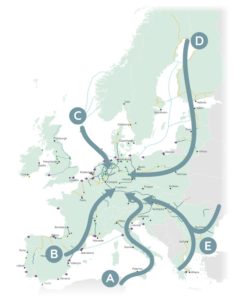Decarbonisation of the economy and energy independence are two objectives that have recently become increasingly important for Europe’s future. In both cases, hydrogen will play a key role and the future European hydrogen corridors will be the infrastructures that will make this vision possible.
The path to decarbonisation depends on the role that hydrogen can play and the development of an infrastructure to create adequate logistics with the necessary security of supply to develop a liquid and competitive European market. To this end, the European Hydrogen Backbone (EHB) initiative aims to boost competition, security of supply and cross-border collaboration based on this new energy carrier.
European Hydrogen Backbone (EHB) aims to boost competition, security of supply and cross-border collaboration
EHB comprises 31 infrastructure operators from 29 European countries, who share the vision of a climate-neutral continent with a strong commitment to deploying a green, low-emission hydrogen market.
Since its foundation in 2020, they have been working to demonstrate that a European hydrogen network is both technically and economically feasible. The regional differences in supply and demand in each of Europe’s territories show the importance of connecting them with each other. Accordingly, their vision is that by 2030 there will be around 28,000 km of hydrogen pipelines linking industrial hubs, ports and hydrogen valleys; which could reach 53,000 km by 2040.
As set out in REPowerEU (the European Commission’s plan to rapidly reduce dependence on Russian fossil fuels), the goal is to produce at least 10 million tonnes of renewable hydrogen on the continent and another 10 million tonnes from imports. All this in order to replace and/or reduce the Russian gas consumed by the European Union and to use it as a substitute in those sectors that are difficult to decarbonise.
To meet REPowerEU’s 2030 hydrogen demand and supply targets, the EU believes that large-scale corridors are needed to enable the transport of large volumes of hydrogen to demand centres at low cost. Initially, the EHB has proposed five corridors, which could be extended in the future:
These five major corridors are in line with the three proposed by REPowerEU (one through the Mediterranean, one from the North Sea and one through Ukraine).

The aim as we have already noted, would be to give Europe the capacity to create a pan-European hydrogen market because, by connecting different parts of Europe, hydrogen can be harnessed wherever it is needed, ensuring a stable and secure supply. It also provides access to large volumes of hydrogen, either by self-production or by import (for example, through the Corridor linking North Africa with Southern Europe, which passes through the Iberian Peninsula).
The result would be a significant decrease in emissions, the development and integration of renewable energy sources and their markets, support for the development of “green, innovative and sustainable” industries, as well as providing a reinforcement of the resilience of the European energy system and greater independence.
The aim would be to give Europe the capacity to create a pan-European hydrogen market
The horizon for completion of these corridors is not far off, but the challenge we face is increasingly urgent. Having the corridors completed by 2030 requires decisiveness and agility to push forward the five measures that EHB proposes to achieve this:
At a time when a country as important in Europe as Germany is considering a return to coal due to the seriousness of the war in Ukraine, while thermometers are reaching historic highs due to climate change, the commitment to a hydrogen market facilitated by European corridors should be at the top of the EU’s political agenda.
Spain’s positioning in this context and the increase in “Hydrogen ready” pipeline interconnections will enable it to reach this liquid hydrogen market as quickly as possible, taking advantage of the window of opportunity that Spain has in the potential for electricity generation from renewable sources and the potential deployment of production plants and their interconnection with this future Spanish hydrogen backbone.